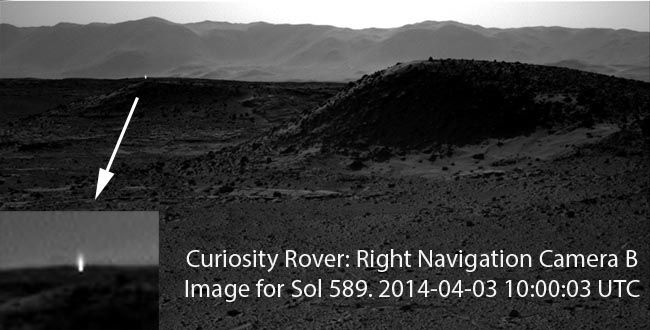
Strange light appears on Mars: evidence of an underground base?
 A photograph just released from the Mars Curiosity Rover reveals a strange nearby light that appears artificial. The image was part of a batch just uploaded from the Mars Curiosity Rover that were originally recorded on April 3, 2014 by the Right Navigation Camera. The image with the time stamp of 10:00:34 UTC shows an unusual light on the Martian surface only a mile or so away. The light does not appear to be related to the sun or any natural atmospheric phenomenon such as dust storms that have been known to produce lightning on Mars. The light is too distant to clearly identify but appears to be coming from underground suggesting an artificial light source located beneath the Martian surface.
A photograph just released from the Mars Curiosity Rover reveals a strange nearby light that appears artificial. The image was part of a batch just uploaded from the Mars Curiosity Rover that were originally recorded on April 3, 2014 by the Right Navigation Camera. The image with the time stamp of 10:00:34 UTC shows an unusual light on the Martian surface only a mile or so away. The light does not appear to be related to the sun or any natural atmospheric phenomenon such as dust storms that have been known to produce lightning on Mars. The light is too distant to clearly identify but appears to be coming from underground suggesting an artificial light source located beneath the Martian surface.
The Curiosity Rover image was uploaded by NASA on April 3, 2014, and was seen by Youtube user Streetcap who posted a video today revealing the strange Martian light.There is no nearby atmospheric activity such as a dust storm that the image or other images in the same batch from the Curiosity Rover reveal. Dust storms can produce lightning as was observed in imagery taken by the Mars Orbiter Camera in June 2006 that was the first confirmation of lightning on Mars.
Another possible explanation is underground lightning which happens on Earth due to the rotation of molten metal beneath the Earth’s crust which creates rotating electric fields vital for creating a powerful magnetosphere. Mars, however, has no inner crustal dynamo comparable to Earth, and its magnetosphere is a fraction of Earth’s. It is therefore unlikely that underground lightning is a naturally occurring phenomenon on Mars. The light emission in the Curiosity Rover image is not likely a result of underground lightning.
Another explanation may be lensflare which is caused by a light source just outside of the image field being captured on camera. The most common source of lensflare is the setting or rising sun. However the light in the Curiosity Mars Rover does not appear to be a lensfIare caused by the sun given the lack of shadows in the nearby terrain. If the light source was from the Curiosity itself, then that would have been observed in the Mars images.
If both dust storm and underground lightning is ruled out, together with lens flare, then it raises the possibility that the light is an emission from some artificial underground source. Consequently, the light anomaly recorded by the Curiosity Rover may be evidence of an underground base on Mars.
© Copyright 2013. Michael E. Salla, Ph.D.
This article is copyright © and should not be added in its entirety on other websites or email lists. Permission is granted to include an extract (e.g., introductory paragraph) of this article on website or email lists with a link to the original.
ShaunS
This is a good one. It does not look like a light source because the light does not fade away uniformly. It looks structural but the structure does not appear to be visible. The height and uniqueness in comparison to the surrounding materials is odd.
This is reflecting the white haze of the sky. A transparent material or a reflective material… but a vertical object vertically orientated. A physical column of reflective material. The nature of the light implies a sort of glass which not only being vertical must also be flat. The material is resistant to weathering and to be shiny must be very hard like a shaft of obsidian.
It’s unusual and unique but may be natural. The structure appears unnatural. A monolith!